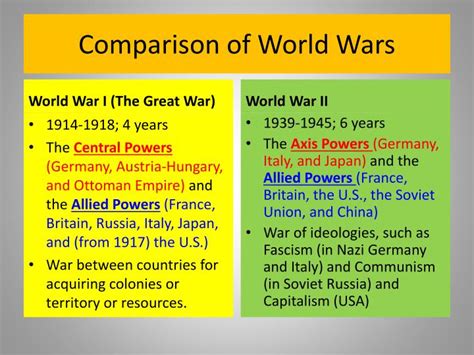Introduction
World War I and World War II, two of the most devastating conflicts in human history, share striking similarities that shaped their course and outcomes. From their geopolitical roots to the technological advancements and human toll, these wars left an indelible mark on the world. This in-depth comparative analysis delves into the key parallels between these two global cataclysms, providing insights into their causes, consequences, and enduring legacy.

Geopolitical Roots
1. Imperialism and Nationalism:
Both World Wars were fueled by the rise of imperialism and nationalism in the late 19th and early 20th centuries. The scramble for colonies and the desire for territorial expansion created tensions between European powers and rivalries between nations.
2. Alliances and Entanglements:
Complex alliances and diplomatic agreements led to the formation of opposing blocs in both wars. In World War I, the Triple Alliance (Germany, Austria-Hungary, Ottoman Empire) faced off against the Triple Entente (France, Russia, United Kingdom). In World War II, the Axis Powers (Germany, Japan, Italy) fought against the Allies (United States, United Kingdom, Soviet Union).
Technological Advancements
3. Industrialization and Mechanized Warfare:
The Industrial Revolution transformed warfare during both World Wars. Mass production of weapons, tanks, aircraft, and other technologies led to the mechanization of combat and increased firepower.
4. Chemical and Biological Weapons:
World War I saw the first widespread use of chemical weapons, such as chlorine gas and mustard gas. While chemical weapons were banned after the war, their horrors paved the way for the development of even more destructive weapons in World War II.
Human Toll
5. Casualties and Suffering:
Both World Wars resulted in staggering human losses. World War I claimed an estimated 17 million lives, while World War II saw an estimated 40-85 million casualties. Civilians bore the brunt of the suffering, with bombings, starvation, and disease devastating entire populations.
6. Displacement and Forced Labor:
Millions of people were displaced from their homes and forced into labor camps during both wars. In World War II, the Nazis subjected millions of Jews and other minorities to concentration camps and death camps, resulting in the Holocaust.
Other Parallels
7. Economic Mobilization:
Governments mobilized their economies for total war, redirecting resources and labor to support the war effort. This led to rationing, labor shortages, and economic disruption.
8. Propaganda and Censorship:
Both wars were accompanied by extensive propaganda campaigns to rally public support and demonize the enemy. Governments imposed censorship to control the flow of information and suppress dissent.
Key Differences
Despite their similarities, World War I and World War II also differed in several key respects:
1. Duration: World War I lasted for four years (1914-1918), while World War II lasted for six years (1939-1945).
2. Scope: World War I was primarily fought in Europe, while World War II spread across multiple continents, including Asia and Africa.
3. Ideological Divide: World War II was characterized by a clear ideological divide between the Axis Powers and the Allies, with fascism and communism on one side and democracy and liberalism on the other.
Conclusion
World War I and World War II, while separated by a generation, share striking similarities in their geopolitical roots, technological advancements, and devastating human toll. Understanding these parallels provides valuable lessons for preventing future conflicts and promoting peace and cooperation among nations. By examining the similarities between these two world wars, we can better appreciate the complex interplay of historical, political, and technological factors that shape the course of human history.
